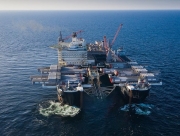This route passes outside Danish territorial waters and stretches within the exclusive economic zone (EEZ) of Denmark.
The EIA is based on detailed environmental research conducted along the pipeline route where the pipeline is planned to be constructed. The comprehensive report describes the main characteristics and technical solutions of the planned pipeline system, as well as detailed assessments of potential impacts on the physio-chemical, biological and socio-economic environment in the Danish sector. The EIA also includes an assessment of potential transboundary impacts which may arise from activities to be carried out in Denmark, and identifies measures to prevent and mitigate potential adverse environmental impacts.
The public, Danish authorities and organizations are invited to provide comments or raise their questionson the filed EIA report to the DEA until 10 July. This deadline is extended to 17 July for the transboundary consultation under the Espoo Convention. A hearing organized by the DEA, where interested parties can raise their questions, will be held in Rønne on Bornholm on 19 June. For additional information, visit the website of the DEA: www.ens.dk/vvm-redegoerelsen-NS2-SE.
Nord Stream 2 AG submitted a third permit application and an EIA to the DEA on 15 April 2019 in order to secure the interests of our shareholder and financial investors, despite our legal reservations. This south-eastern route runs through an area that was previously disputed between Poland and Denmark, and therefore not available for any project developer.
The permit application and EIA were submitted following a decision made by the DEA on 26 March. Nord Stream 2 AG, however, appealed the DEA’s decision on 17 April as we consider its request for a third permitting and consultation procedure disproportionate and illegal.
Nord Stream 2 AG already has two other separate route applications pending with the DEA. The first, applied for in April 2017, is based on the guidance received from the Danish authorities for the existing Nord Stream Pipeline and crosses Danish territorial waters. The second application, applied for in August 2018, is an alternative route in Danish EEZ passing north-west of Bornholm. At this time, the north-western route was the environmentally preferred route within the Danish EEZ.
In accordance with the permits already granted in four countries, work on the Nord Stream 2 Pipeline is ongoing in Russia, Finland, Sweden and Germany. More than 1,200 kilometres of the two lines – more than half of the total distance – have already been laid.
03 Января 2026 | суббота | 18:49


